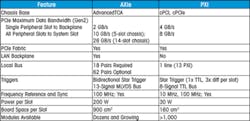Exploring the Relationship Between AXIe and PXI
As AXIe emerges from infancy to become a capable measurement platform, it’s easy to see the common DNA it shares with PXI. Both platforms are standard modular form factors that boast low-latency, high-throughput backplane buses based on PCI Express. However, PXI has staked its claim in automated environments such as manufacturing test that need a small footprint, low power, and high throughput. Because AXIe provides roomier slot volume, greater board space, and higher power, it may be destined for similar success as it matures.
Certain applications can clearly benefit from the advantages of AXIe, and the range of emerging AXIe-based instruments includes logic analyzers, protocol analyzers, and advanced arbitrary waveform generators. The common thread is high-speed, high-channel-count, bleeding-edge measurement technologies—digital or analog—that require the ample resources AXIe provides.
Similar but Different
AXIe has been designed to complement PXI in areas where high-performance measurements could not be achieved previously. PXI will continue to thrive in low-cost, small-footprint, and power-conservative automated test environments. In contrast, AXIe makes modular solutions more viable in research, advanced labs, and R&D—environments in which PXI struggles to compete due to its power constraints and 3U instrumentation space.
A quick look at a few details reveals the underlying similarities and differences offered by AXIe. As the table shows, AXIe and PXI offer similar latency and transfer speeds because both use PCI Express as the backplane fabric.
AXIe adds some useful enhancements that support the needs of higher performance instrumentation. One is the local bus, which is capable of intermodule communications of more than 600 GB/s. Another is triggering: While AXIe uses the same trigger concepts as PXI and offers similar clocking and point-to-point capabilities, it also provides a 100-MHz multidrop parallel capability. In addition, AXIe is based on Advanced TCA (ATCA), which means an AXIe-based system can use high-performance ATCA computer modules as plug-in measurement servers.
Ahead of the Curve
With this mix of capabilities and resources, AXIe manufacturers have an opportunity to deliver cutting-edge performance in digital and analog applications that require the latest in ASIC and measurement technologies. Also, with its modular form factor, AXIe enables manufacturers to deliver advanced technologies to market more quickly than previously was possible in standalone box-based architectures.
The list of solution creators interested in implementing unique instruments for specific applications includes early adopters, system integrators, and even end-user customers. All will soon have access to AXIe developer kits that provide the tools needed to accelerate the development of unique modules and solutions.
Plays Well With Others
Looking ahead, four points are worth remembering:
• PXI and AXIe can coexist in the same test environment because they use the same backplane fabric.
• AXIe is compatible with the PXI software architecture.
• Power, module volume, module board space, and the high-speed local bus make AXIe a great platform for the latest measurement technologies and customization via ASICs.
• The upcoming developer kits will enable early adopters to build AXIe systems with confidence.
While the relationship may be seen as complex between AXIe and PXI, there is familiarity between the standards that, depending on test requirements, can be straightforward. For system creators, it isn’t a matter of playing favorites. Instead, it’s about selecting the right platform for the right application—and, fortunately for all, the choices have never been better.

